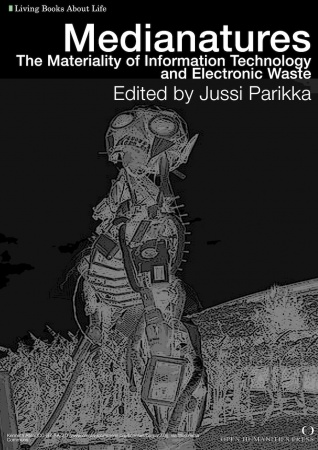Timothy Lenoir (ed.): Inscribing Science: Scientific Texts and the Materiality of Communication (1998)
Filed under book | Tags: · cartography, communication, germany, history of science, information, materiality, photography, science, semiotics, technology

Early practitioners of the social studies of science turned their attention away from questions of institutionalization, which had tended to emphasize macrolevel explanations, and attended instead to microstudies of laboratory practice. Though sympathetic to this approach—as the microstudies included in this book attest—the author is interested in re-investigating certain aspects of institution formation, notably the formation of scientific, medical, and engineering disciplines. He emphasizes the manner in which science as cultural practice is imbricated with other forms of social, political, and even aesthetic practices.
This book offers case studies that reexamine certain critical junctures in the traditional historical picture of the evolution of the role of the scientist in modern Western society. It focuses especially on the establishment of new disciplines within German research universities in the nineteenth century, the problematic relationship that emerged between science, industry, and the state at the turn of the twentieth century, and post-World War II developments in science and technology.
After an Introduction and two chapters dealing with science and technology as cultural production and the struggles of disciplines to achieve legitimation and authority, the author considers the following topics: the organic physics of 1847; the innovative research program of Carl Ludwig as a model for institutionalizing science-based medicine; optics, painting, and ideology in Germany, 1845-95; Paul Ehrlich’s “magic bullet”; the Haber-Bosch synthesis of ammonia; and the introduction of nuclear magnetic resonance instrumentation into the practice of organic chemistry.
Publisher Stanford University Press, 1998
Writing Science series
ISBN 0804727775, 9780804727778
476 pages
Jussi Parikka (ed.): Medianatures: The Materiality of Information Technology and Electronic Waste (2011-)
Filed under living book | Tags: · ecology, ecosophy, electronic waste, energetics, energy, materiality, media ecology, naturecultures, technology

“Medianatures picks up from Donna Haraway’s idea of naturecultures – the topological continuum between nature and culture, the material entwining and enfolding of various agencies, meanings and interactions. Medianatures gives the concept of naturecultures a specific emphasis, and that emphasis is at the core of this living book. It is a useful concept and framework for investigating some of the ways in which our electronic and high-tech media culture is entwined with a variety of material agencies. The notion of ‘materiality’ is taken here in a literal sense to refer, for instance, to ‘plasma reactions and ion implantation’ (Yoshida, 1994: 105) – as in processes of semiconductor fabrication, or to an alternative list of media studies objects and components which are studied from an e-waste management perspective: ‘metal, motor/compressor, cooling, plastic, insulation, glass, LCD, rubber, wiring/electrical, concrete, transformer, magnetron, textile, circuit board, fluorescent lamp, incandescent lamp, heating element, thermostat, brominated flamed retardant (BFR)-containing plastic, batteries, CFC/HCFC/HFC/HC, external electric cables, refractory ceramic fibers, radioactive substances and electrolyte capacitors (over L/D 25 mm)’, and which themselves are constituted from a range of materials – plastics, wood, plywood, copper, aluminum, silver, gold, palladium, lead, mercury, arsenic, cadmium, selenium, hexavalent chromium and flame retardants (Pinto, 2008).” (from Introduction)
Publisher Open Humanities Press
Living Books About Life series
View online (wiki/PDF/HTML articles)
PDF (PDF’d Introduction with hyperlinked articles)
Matthew G. Kirschenbaum: Mechanisms: New Media and the Forensic Imagination (2008)
Filed under book | Tags: · digital forensics, electronic literature, forensics, hypertext, literature, materiality, storage, textuality, writing

“In Mechanisms, Matthew Kirschenbaum examines new media and electronic writing against the textual and technological primitives that govern writing, inscription, and textual transmission in all media: erasure, variability, repeatability, and survivability. Mechanisms is the first book in its field to devote significant attention to storage—the hard drive in particular—arguing that understanding the affordances of storage devices is essential to understanding new media. Drawing a distinction between ‘forensic materiality’ and ‘formal materiality,’ Kirschenbaum uses applied computer forensics techniques in his study of new media works. Just as the humanities discipline of textual studies examines books as physical objects and traces different variants of texts, computer forensics encourage us to perceive new media in terms of specific versions, platforms, systems, and devices. Kirschenbaum demonstrates these techniques in media-specific readings of three landmark works of new media and electronic literature, all from the formative era of personal computing: the interactive fiction game Mystery House, Michael Joyce’s Afternoon: A Story, and William Gibson’s electronic poem ‘Agrippa.’
Drawing on newly available archival resources for these works, Kirschenbaum uses a hex editor and disk image of Mystery House to conduct a “forensic walkthrough” to explore critical reading strategies linked to technical praxis; examines the multiple versions and revisions of Afternoon in order to address the diachronic dimension of electronic textuality; and documents the volatile publication and transmission history of ‘Agrippa’ as an illustration of the social aspect of transmission and preservation.”
Publisher MIT Press, 2008
ISBN 0262113112, 9780262113113
296 pages
PDF (no OCR; some pages missing; updated on 2014-3-5)
EPUB (added on 2018-7-30)

